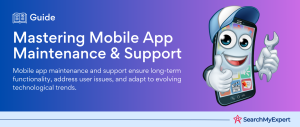In today’s digital ecosystem, mobile applications have become a pivotal tool for businesses to thrive and maintain a strong online presence. With the constant evolution of technology and the burgeoning demands of consumers, it’s imperative for businesses to develop mobile apps promptly without sacrificing their quality. Here are twelve strategic approaches to expedite the mobile app development process.
1. Embrace the MVP Philosophy
Minimum Viable Product (MVP) has emerged as a core principle in the app development domain. It encourages launching a product with essential features to test its viability in the market. The primary benefits of MVP include:
- Rapid Market Testing:Launch with fundamental features to garner user feedback.
- Iterative Development:Use real-time data to refine the product over multiple iterations.
- Cost Efficiency:Focus on primary functionalities, which can lead to reduced initial development costs.
Remember, MVP isn’t about minimal effort but about introducing an operational product to evaluate its market potential.
2. Implement Agile Development
Agile Development is a paradigm shift from traditional methods, focusing on:- Short Release Cycles: Facilitates early and frequent releases with iterative improvements.
- Feedback-Driven Development: Real-time feedback ensures alignment with user needs and market trends.
- Prioritization: Crucial features are developed and launched first, leading to quicker market entry.
By adopting Agile, businesses can achieve flexibility, prompt market entry, and an enhanced user-centric approach.
3. Utilize Cross-Platform Development Tools
To ensure an app’s ubiquity, it’s vital to have it available on multiple platforms. Cross-platform development tools enable:- Code Reusability:Write once and deploy on both Android and iOS.
- Time Efficiency: Eliminate the need for separate codebases for different platforms.
- Examples: Tools like Adobe Phonegap and Xamarin facilitate development across multiple platforms while maintaining performance and user experience.
4. Adopt Low-Fidelity Wireframing
Before diving into development, a visual blueprint or wireframe of the app is crucial. Opting for low-fidelity wireframes offers:- Unified Vision: Provides a visual guide for developers and stakeholders.
- Efficiency:Identify and address potential design and UX challenges early on.
- Tool Options: Platforms like Adobe Photoshop, Balsamiq, and MockFlow are excellent for creating these wireframes.
5. Consider Outsourcing Opportunities
Outsourcing specific components of the app development can be both time-efficient and cost-effective. Key advantages include:- Skill Optimization:Leverage external expertise for components outside the in-house team’s core strengths.
- Cost-Effective:Hiring specialized teams on an hourly basis can lead to considerable savings.
- Focus: In-house teams can concentrate on primary app components, ensuring quality and efficiency.
6. Leverage Automated Testing Tools
Quality assurance is vital, and testing can be a lengthy process. Automated testing tools like Appium facilitate:- Efficiency:Perform rigorous tests in less time.
- Cross-Platform Testing: Appium and similar tools allow testing across various platforms with a single script.
- Accuracy:Automated tests reduce human error, ensuring consistent quality checks.
7. Prioritize User Experience (UX) and User Interface (UI) Design
In the age of digital transformation, an app’s usability often determines its success. Prioritizing UX/UI design can lead to:- Increased User Engagement: A streamlined interface and experience can boost user retention.
- Positive Brand Perception: A well-designed app reflects positively on your brand and can improve trustworthiness among users.
- Efficient Development: By identifying and solving design-related issues early, developers can reduce time spent on revisions later in the process.
8. Incorporate Feedback Loops
Establishing a robust feedback mechanism is paramount. It enables:- Continuous Improvement:User feedback provides direct insights into areas of improvement.
- Enhanced User Satisfaction:Demonstrates to users that their input is valued and acted upon.
- Data-Driven Decisions: Instead of assuming user needs, developers can make informed changes based on actual feedback.
9. Invest in Cloud Integration
With the proliferation of cloud services, integrating cloud capabilities can significantly accelerate app development:- Scalability: Cloud services automatically adjust resources based on an app’s requirements.
- Data Security:Trusted cloud providers offer advanced security protocols, ensuring data protection.
- Real-time Collaboration: Cloud platforms allow development teams to collaborate in real-time, streamlining the development process.
10. Stay Updated with Latest Technologies
The tech world is ever-evolving. Keeping abreast of the latest trends and tools can provide a competitive edge:- Incorporate New Features:Leveraging the latest technologies can help in adding innovative features to your app.
- Optimize Performance: New tools and frameworks often offer enhanced performance and efficiency.
- Future-Proofing: Staying updated ensures that the app remains relevant and compatible with future technological advancements.
11. Continuous Integration and Continuous Deployment (CI/CD)
Implementing a CI/CD pipeline can be a game-changer for speeding up app development:- Automated Builds: Automatically compile and build the project after every change.
- Real-time Error Detection:Immediate feedback on the system’s status helps in quick error identification and rectification.
- Faster Releases: With automated deployment, new features and updates can reach users more swiftly.
12. Focus on Modular Architecture
Adopting a modular approach in app development ensures:- Flexibility: Modules can be updated independently without affecting the entire application.
- Efficiency:Parallel development of different modules can speed up the overall process.
- Reusability:Common modules can be reused in different parts of the app or even in other projects, saving development time.
Concluding Thoughts
Accelerating mobile app development without compromising on quality requires a balanced blend of strategy, technology, and user-centric focus. By implementing these practices, businesses can ensure they not only deliver applications quickly but also produce offerings that resonate with user needs and stand out in the competitive marketplace. Embracing these techniques will lead to efficient workflows, reduced time-to-market, and, ultimately, successful and impactful mobile applications.Chart New Territorieswith the innovation of these Mobile App Developers.
Table of Contents
Toggle






